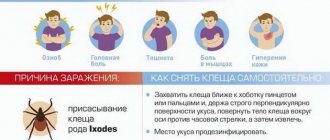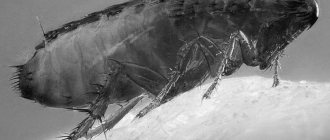Which ticks are the most dangerous in the forest?
The most dangerous and widespread tick on all continents is the ixodid tick; you can also hear other names for this species: forest tick, encephalitis tick. Usually the parasite is about a centimeter in size, but when it is full, it can become much larger than its hungry relative and reach 2.5 centimeters.
Many people wonder what a forest tick is and why it is dangerous? As soon as the tick bites through the human skin, an anesthetic is injected, which lasts for several hours. It is for this reason that sensitivity decreases and, accordingly, the tick is difficult to detect immediately. And this is dangerous, since ticks can be carriers of deadly diseases!
This is interesting: only female forest ticks drink blood; they need it in order to lay eggs.
It is also worth special attention that the forest tick does not hunt when the temperature drops to 10 degrees, even if it is night or evening. At the same time, bloodsuckers are afraid of humidity, so they will not attack when there are drops of dew on the grass. When it's hot outside, ticks are active mainly in the evening and at night. The brightest period of mite activity occurs during bud break on the birch tree.
a brief description of
Forest ticks love moisture and dark places, so they most often live where there is tall and thick grass that retains moisture well. Ticks are also quite often found on forest edges and along river banks. Their habitat is the southern part of Eurasia.
Ticks love to sit on grass that grows along paths where animals and people often move. Their smell attracts ticks: they understand that they can eat.
The reproduction of forest ticks depends on the living conditions: the more moisture and shade, the more actively they reproduce, producing large offspring. Mating occurs before the ticks drink blood. One male fertilizes several females at once, after which his life cycle ends. Females immediately begin to look for food for themselves. Having attached themselves to a person or animal, they drink blood for 5-10 days, and then lay eggs. One female can lay up to 1000, and sometimes more, eggs at a time. © https://ydoo.info/qa/lesnye-kleshchi.html The recorded maximum number of clutches is 5000. After the female has given birth, she dies.
Not all ticks feed on blood. There are other representatives of this group - saprophages. They do not carry dangerous diseases, but when they come into contact with human skin they can cause irritation and redness. The main food of saprophages is organic matter, which decomposes. These can be worms, as well as cultivated plants, which is why saprophages are considered pests that spoil the crop.
What do forest ticks look like?
The only thing a person knows about what a forest tick looks like is that it is small. It can truly be called one of the smallest representatives of the animal kingdom. The body length of a forest tick is from 0.2 to 0.5 millimeters
After the tick sucks blood, its size doubles, that is, up to 10 millimeters (see photo).
There are two types of bodies:
- whole;
- divided into two parts.
A tick larva has 6 pairs of legs, and an adult (more precisely, after the first molt) already has 4. The first two limbs are grippers, with the help of which the animal captures prey. As a rule, ticks have 4 eyes, but there are individuals that do not have them at all. Depending on the species, the body of ticks can be soft, with a thin chitinous coating or protected by a hard shell.
Lifespan
It is impossible to answer exactly how long a forest tick lives with one number, since its life cycle directly depends on the species. In individuals that feed on blood, the new generation hatches shortly after the female lays her eggs. In humid conditions this occurs within a week.
After the larvae hatch, they must find food for themselves. And during this period they are most dangerous, since it is almost impossible to notice them. Their size does not exceed 0.2 millimeters. But a person should not be afraid of them, since they are not yet capable of breaking through the skin. To adapt to life, they must feed on the blood of a small vertebrate animal for 5 days. Then they leave the body of the prey and molt in the grass, moving into the nymph stage (they already have 4 pairs of legs), and then again look for food. As a rule, by this time the cold weather sets in, and forest ticks in the nymph stage hibernate. How do ticks winter? Falling into suspended animation, forest ticks can remain without food for quite a long time. But if in winter the temperature is very low (-20 degrees and below), then the forest tick will die.
Small parasites are almost constantly in search of food. At the same time, even without food they live for quite a long time. Forest ticks can search for prey for up to several weeks without dying. And when they find prey, they completely restore their strength.
If a forest tick gets into an apartment and does not cling to a person, it dies within 3-5 days (depending on how full it is). In apartment conditions, he is not on his own territory, there is no moist soil and the necessary temperature, so it is more difficult for him to exist. But if a forest tick has entered an apartment and is thoroughly saturated with human blood, then it can “walk” around the rooms for several more weeks.
What are they afraid of?
What are forest ticks afraid of? Many people think that high temperatures. Actually this is not true. When it is very warm and dry, it is more difficult for them to live and find food, but they do not die from the heat.
However, there are a few things that wood mites don't like:
- Essential oils. As a rule, they cannot tolerate the smell of citrus and eucalyptus. Also, forest ticks do not like the smell of geranium, mint, cedar, and cloves.
- Liquid smoke.
- Tar soap. Before going to nature, you can wash your clothes with soap - and not a single tick will attack.
- Anthill. These insects secrete acid, which mites cannot tolerate, so it is impossible to find them near ants.
In folk remedies that do not like forest ticks, wormwood is often used. It is planted in vegetable gardens to repel pests from cultivated plants. In addition, sprays are prepared based on wormwood.
Appearance of the parasite
The popular belief that a tick is an insect is completely wrong. In fact, this parasite is an arachnid.
The length of a tick is usually no more than three millimeters. The average length of the parasite is even less: 0.1-0.5 millimeters. Does a tick have wings? Just like any arachnid, the parasite has no wings at all. However, adult individuals have four legs, while forest ticks that have not reached puberty can boast only three.
It is interesting that the tick does not only have wings: the bloodsucker also does not have eyes. This does not prevent them from being able to navigate the terrain well, due to their very developed sensory apparatus. It is thanks to their developed senses that forest ticks can smell a possible victim at distances that are large for their size - ten meters.
Ticks can be divided into separate sections:
- Leatherbacks with fused head and chest. They inhale air using the trachea and skin. Photos of the tick are presented below
- Armored with a head attached to the body. Breathing in this species is possible with the help of special spiracles. Photos of the tick are presented below
general description
Ticks are classified as arachnids, but they also have similarities with beetles. It turns out something in between. Each species has its own unique features, but, unfortunately, they cannot be detected without a microscope. A person who does not have special knowledge can distinguish one species from another only by color. Although in this case the color scheme is not variegated. The tick goes through several stages: larva, nymph and mature individual. In size, an individual can reach 5 mm. And the larva is only 0.2 mm. It consists of a body and a head. An adult parasite has 8 legs. There is a proboscis on its head, with which it sucks blood. On its paws there are radars that allow it to detect prey and suction cups with which it easily clings.
Ticks are divided into several types: harvest mites, acarimorphs and parasitimorphs. The first two groups include harmless species, but the last one includes predatory representatives of the order.
Appearance
Ixodid ticks . This group includes a variety of predators. They are the carriers of diseases. The average size is about 3 mm. Gradually becoming saturated, the tick swells several times and can reach a size of 3 cm. By how much it has grown, one can judge how long it has been parasitizing.
This species lives throughout the globe. The body is flat, oval. The structure of the female and male is different. The male has a dense shell, while the female has a more elastic body. The color changes depending on whether the individual is hungry. A hungry representative may have a yellow, brown or black body color. And after the parasite is fed, it acquires a pink or gray tint. Parasites do not live long. The male dies after mating, and the female after laying eggs. Not many reach sexual maturity. The peak of ticks is May. After a long winter, they begin to crawl out in search of food for themselves and their offspring.
There are 600 species of Ixodidae. But the most dangerous of them are: dog, taiga and pasture. All of them can be classified as encephalitis, since they are the most frequent spreaders of the virus.
Encephalitis tick photo can be seen below. Externally, ixodid ticks are not very different.
Dog tick . It is also called European or forest, brown. Prefers to settle in coniferous or deciduous forests, in secluded places in a humid environment. It's in the south. But in northern latitudes it prefers dry, open places and loves sunlight. The body of the tick is oval. The color is brown, sometimes there are other shades of gray or brown.
Taiga tick . The main habitat is the taiga in Siberia. This is where the name came from. But now he can often be found outside of it. The taiga tick lives for a long time: up to 4 years. And the dog is only 4 months old. The taiga tick is quite large and reaches a size of 1 cm. The color can change depending on several factors: whether it is a female or a male, whether the individual is hungry and the color of the habitat.
Pasture mite . Well, everything is simple here - this species lives near pastures, in open areas. Sometimes found in the forests. Reaches a size of 0.5 cm. Color can vary from gray to olive.
Argasid mites . They are also carnivores and parasitize warm-blooded animals. They mainly feed on small rodents. The body is oblong, the shell is orange or brown. One of the most dangerous types of ticks, they can live without food for more than five years. They reach a size of 3 cm. They can feed several times during their life.
Gamasid mites . These parasites reach small sizes, about 0.3 mm. The color is usually light brown. The main source of food is rodents and birds, but it is not uncommon for gamas ticks to attack people. They are carriers of diseases transmitted by rodents. This group includes several different species.
Scabies itching . From the name it is already clear why this species is dangerous. These little parasites are carriers of scabies. Due to their microscopic size, it is impossible to detect them at home. Most often, this species lives in the armpits. Signs: itching, redness, inflammation. The female does not live long in the epidermis, but she is capable of laying eggs, which will lead to the reproduction of offspring and the development of the disease.
Subcutaneous mite . They live in the skin, mainly on the face. Some subspecies can collect on hair. Almost every person has this type of mite; they do not cause much harm. But if your immune system is weakened, the mite becomes more active and can cause a skin disease - demodicosis. A tick can only be seen under a microscope.
Dust mite . Frequent guests in our homes. This type of mite is also microscopic, so it cannot be seen. Does not pose any threat, but is dangerous for people with allergies. May cause the development of more serious diseases. Lives in laundry, toys and other places where dust accumulates.
Soil mite . This representative of the squad does not harm humans directly. He is interested in crops. The mite burrows into the soil and feeds on the roots of plants, which leads to their death. The mite size does not exceed 1 mm, the color is bright yellow. You can get rid of it using special chemicals.
Barn mite . Unlike the soil species, this species can live not only in the garden. It can live anywhere, even in a jar of flour in the closet. It is a carrier of various bacteria, therefore, after its discovery, you should under no circumstances eat anything from the place where it was found. It barely reaches half a millimeter in size. Color beige, light brown. In places where it appears, it is characterized by the formation of a brown crust and a minty odor.
Armored mite . Not all types of ticks are harmful; one of them is armored. This individual brings more benefits. It feeds on rotted remains, thus cleaning the soil.
Spider mite . Not dangerous to humans, settles on indoor and garden plants. The mite slowly eats it, which leads to the death of the plant. Most often it is red. Size 0.6 mm.
What danger do forest ticks pose to humans?
The small size of the forest tick should not fool you into thinking that these parasites are quite harmless insects. In order to understand the danger forest ticks pose to humans, it is enough to list some of the diseases that bloodsuckers can transmit through a bite.
First of all, forest ticks can infect:
- Borreliosis, also known as Lyme disease
- Rickettsial disease
- Viral fever
- Encephalitis
- Tick-borne typhus
- Tularemia
- "Tick paralysis"
And this is not the entire list. You will be surprised, but forest ticks can cause about sixty different diseases. In addition to people themselves, domestic animals, including dogs, cats and horses, can also be affected. And even though a person is often successfully cured, there are diseases that can be fatal. One of these may be encephalitis, since in severe forms of the disease the brain becomes inflamed, which often causes death. But even with successful treatment, certain complications of a psychiatric or neurological nature may occur.
Borreliosis, which is infectious in nature, has recently become widespread. The person experiences severe headaches, a fever sets in and overcomes a feeling of apathy. The disease is also characterized by the appearance of a skin rash over the body, the so-called erythema migrans. If treatment is not started immediately, complications may occur that can lead to disability.
Taking into account all the above data, it is better, after detecting a forest tick bite, to contact the appropriate sanitary and epidemiological station departments to make sure that nothing threatens you. Otherwise, this will help to start treatment in a timely manner.
Red heifers
A very small type of parasite. Adults are about 1 mm in size, larvae are 0.02 mm in size. Larvae parasitizing mice cause thrombidiasis in humans. Signs of thrombidiasis:
- itchy, inflamed spots;
- nodules;
- pustules.
The signs are very similar to flea bites.
On a note!
Since clothing prevents the larvae from spreading freely throughout the body, the main affected area in humans is the ankles.
When bitten, larvae can transmit some infectious diseases:
- Q fever;
- tsutsugamushi;
- African tick-borne rickettsiosis.
Red beetles
Thrombidiasis is caused by the larvae themselves. Their food is not blood, as for ixodids, but skin cells. The larvae of red mite mites live under the skin, in the hair follicles. The body reacts to the introduction of the larvae by the formation of irritated spots and itching. Scratching can cause a complication - pyoderma. The latter is caused by pyogenic cocci. After feeding for several days, the larvae fall away from the host and the remaining stages of transformation take place on the ground.
What should I do if bitten by a tick?
Obviously, the forest tick poses a considerable danger to people, which is why it is important not only to get rid of the parasite when a bite is detected, but also to check it for the presence of any diseases.
The best solution would be to have the bloodsucker removed directly by a doctor to get rid of problems in the future. However, it is not always the case that it is possible to visit a specialist to remove the parasite, so you need to carry out the procedure yourself.
Before proceeding with removal, you must wash your hands thoroughly. It is better to use soap to avoid infection. Alcohol or an alcohol solution is good for treating the bite site, but it must be treated in such a way as not to hurt the pest. As soon as the preparatory part comes to an end, you need to pick up tweezers or thread. Under no circumstances should you use your fingers to remove them, as they are too wide for the procedure. It is necessary to wrap the proboscis and unscrew it from the skin by turning it.
To make it easier to imagine how this movement occurs, think about the fact that you need to turn a mechanism that is well lubricated. There is no need to put special pressure on yourself, cause unnecessary inconvenience to yourself, or put in a lot of effort. The person who removes the forest tick must allow it to crawl out of the victim’s skin on its own.
Remember that the remaining parts of the pest also pose a danger to people, so they also need to be removed. After the procedure, you need to walk over the affected area again with alcohol to disinfect the area. Often the main problem arises here: the tick’s proboscis becomes tightly stuck in the victim. In this case, you need to wait a certain time. If it does not fall off on its own when the wound dries, you need to visit a doctor.
Actions to take if bitten by a tick
Not every tick is infected, but the possible danger should not be underestimated. With timely medical care, even an infected tick will not cause harm or it will be minimal. If it is not possible to promptly contact a medical facility, the tick must be removed on your own. When removing a parasite, it is important to not allow the parasite to rupture. In this case, the head will be under the skin, and it is in the head that all the toxic substances are concentrated. There are several basic methods for removing ticks.
Removal using tools
Devices for self-removal of ticks are available in the form of plates with a drop-shaped hole and spoons or hooks with a V-shaped slot. The embedded tick must be pryed as deep as possible under the head and carefully pulled out using twisting and rocking movements. All tools are small in size and can be used as key rings. Products available include Tick Twister and Trixie hooks, Ticked Off spoon, Pro-Tick and Tick Key plates.
Tick removal hook
The Tick Remover, which is similar in principle to a collet pencil, deserves attention. Among the domestic tools we can name tweezers for removing ticks Anti-Mite. Anti-Mite differs from ordinary tweezers in its triangular working part made of wire, which is convenient for capturing the parasite. The principle of operation is the same: the tick is grabbed as close to the head as possible, swings and turns outward.
In the absence of special tools, you can use ordinary medical tweezers, but in this case the risk of tick rupture increases. The original method is to extract the parasite using a regular disposable syringe. The cylindrical part of the syringe is cut off from the side where the needle is attached, the resulting hollow cylinder is pressed tightly to the bite site so that the tick is inside. After this, the piston is pulled out, and the spider jumps out under the influence of vacuum.
Removal without tools
The most well-known method is to remove the tick using a harsh thread or thin rope. The insect must be wrapped in a loop, loosened and carefully removed, continuing to swing from side to side. The method of removal using oil is considered dangerous; doctors are categorically against its use. The removal principle is based on the assumption that if you drop oil on an embedded parasite, it will begin to suffocate and crawl out of the wound on its own. This is not to say that this is impossible, but first the tick can regurgitate inside the person everything that it managed to suck out. It is possible that the spider will simply suffocate and die, remaining in the body. A very extreme method is to remove the tick with your fingers. The risk of crushing the parasite in such cases is extremely high. If the extraction is carried out by another person, then the infection can spread to him.
What to do after extraction
If extraction was unsuccessful and the head remained under the skin, it must be removed with a disinfected needle. After extraction, in any case, the wound is treated with iodine, alcohol (vodka) or another disinfectant solution. The extracted tick must be submitted to a laboratory for testing. If an insect is removed in a medical facility, such a study is required. For greater safety, the extracted tick is placed in a plastic bag or glass flask (vial) with soaked pieces of paper.
Preventive actions
In order to protect against ticks in places where they may live, it is necessary to wear tight clothing that covers all parts of the body. A headdress or scarf is required. Ticks live at a height of about 1 m above ground level; falling from above rarely occurs. The parasite can also attack from the ground, and does not immediately bite into it. He begins to climb up in search of a comfortable place. It can take several hours from the moment of contact with the body to the bite, so after returning home you need to carefully examine not only your body and your pet, but also your clothes. Particularly attractive areas for ticks are the armpits, groins and neck. A tick bite is painless.
The right clothes for the forest
Among the medical means for protection we can recommend:
- repellent (repellent): Gall-RET, Deta-WOKKO, Biban, Reftamid maximum, Off! Extreme, DEFI-Taiga;
- acaricidal (killing): Reftamid taiga, Tornado-Antiklesch, Fumitox-anti-mites, Permanon, Piknik-Antiklesch, Gardex aerosol extreme;
- complex (repellent and killing): Kra-rep, Mosquito-anti-mite.
Correct actions will prevent a tick bite, and even if this happens, it will allow you to avoid serious consequences.
Are forests sprayed against ticks today?
This practice has not been used for a long time, so there may be quite a lot of these parasites in the forests. You need to fight the pest yourself. It will be much easier to spend a little time on prevention and protect yourself from tick bites than to solve a problem associated with serious diseases in the future.
In addition to treating park areas with chemicals against ticks, these insects also have natural enemies who are not averse to eating them. Who is this? We will talk about this with you further...
Diagnosis of tick-borne encephalitis
- A correctly collected epidemiological history will help establish the diagnosis. The patient’s stay in the forest, information about tick bites and consumption of raw goat’s milk are the main points that need to be paid attention to.
- Increasing headache and fever, nausea and vomiting, insomnia or drowsiness, lethargy and adynamia of the patient are early diagnostic signs of the disease.
- Detection of antibodies to the tick-borne encephalitis virus using the enzyme-linked immunosorbent assay (ELISA).
- Increase in antibody titer using RSK, RTGA, RPGA, RDNA and neutralization reaction. A 4-fold increase in antibody titer is an important diagnostic sign of tick-borne encephalitis. IgG antibodies are specific for tick-borne encephalitis.
- Isolation of tick-borne encephalitis virus by bacteriological method (method of inoculation on a nutrient medium).
Tick-borne encephalitis viruses and antibodies to their antigens are detected already in the first week of the disease.
Rice. 22. The photo shows tick-borne encephalitis viruses.
Who eats forest ticks?
First of all, in answering the question of who eats forest ticks in nature, it must be said that ticks are in last place in the food chain, which means that forest ticks have plenty of enemies.
- In the first place are birds, primarily sparrows, which are not averse to feasting on ticks.
- In second place are insects such as dragonflies, ichneumon wasps, ground beetles and bugs.
- In forests, it is better for ticks not to meet ants, especially large red forest ants, since ticks are part of their diet.
- In water bodies, the enemies of the forest tick are frogs, toads, lizards and other amphibians.
Note: forest ticks occupy an important place in the food chain. If there are no parasites at all, then entire species of insects and birds that feed on them may disappear!
Epidemiology of tick-borne encephalitis
How are tick-borne encephalitis viruses transmitted?
- Transmission of viruses is carried out by ixodid ticks (usually Ixodes persulcatus) during blood sucking (80 - 90% of cases).
- Rodents (hares, hedgehogs, chipmunks, field mice), birds (thrushes, goldfinches, redpolls and finches), predators (wolves) are an additional reservoir of infection.
- Viruses can enter the human body by consuming raw milk from infected goats, and much less often from cows.
- Transmission of viruses can occur when an infected tick is crushed while removing it from the surface of the skin.
Bites of infected ticks and consumption of raw goat's milk (less often cow's milk) are the main factors in the transmission of neurotropic viruses in the mid-latitudes of Russia.
The most common types of ticks in the Russian Federation
Of the 40 thousand species of known ticks, only a few have become parasites. In the process of evolution, they adapted to feed on the blood of animals. The most studied to date are ixodid ticks (family Ixodoidea), numbering more than 700 species.
In our country, farm animals and humans are most susceptible to tick bites from Ixodes ricinus and Ixodes persulcatus. The most aggressive ticks towards humans are Ixodes persulcatus.
Ixodes persulcatus (taiga tick) is common in a number of areas of the Asian and European parts of our country.
Ixodes ricinus (European forest tick or dog tick) is common in the European part of our country.
How to deal with forest ticks?
Many people prefer to spend their free time outdoors, in particular in the forest. It is in this case that it is necessary to turn to preventive measures that will help avoid tick bites. What should you do first to combat the parasite?
When going to the forest, you need to dress closed so that the bloodsuckers do not have the opportunity to attack you. It is better to purchase special clothing or equip yourself so that forest ticks do not have access to the skin. Pants should be tucked into shoes and the sleeves should be close to the skin.
Each walk should end with a thorough inspection of all dangerous places. In most cases, ticks are found on the neck, in the armpits, on the inside of the elbow or under the knee.
It is better to purchase a cream or aerosol that will repel ticks, and use it on everything you are going to wear, as well as exposed areas of the skin.
It will be a plus if you wear light-colored outerwear. In this case, the bloodsucker will have less chance of clinging to you, and you will have the advantage of instantly detecting it. The head must be covered, as forest ticks love to crawl under the collar.
Dry places and direct sunlight often avoid the pest. Try to stay away from dense bushes.
If you know that you will need to be in nature for a long period of time over several days, and especially in a place where there is a high probability of encountering forest ticks, get vaccinated.
Tick-borne encephalitis virus
Tick-borne encephalitis virus belongs to:
- genus - Flavivirus (group B),
- family - togaviruses,
- ecological group - arboviruses.
Rice. 2. The photo shows the tick-borne encephalitis virus. On the left is a diagram of the structure of the virion, on the right is a view of viruses under an electron microscope.
- The virus is resistant to low temperatures and drying, but quickly loses its biological properties at room temperature.
- When boiling, the virus is inactivated after 2 minutes, and at a temperature of 60°C (the temperature of hot milk), the virus dies only after 20 minutes. The virus persists for up to 10 days at a temperature of 16-18°C. The virus persists in dairy products for up to 2 months.
- Rapid inactivation of viruses occurs under the influence of disinfectants (phenol, alcohol, formaldehyde). Ultraviolet radiation has a detrimental effect on pathogens.
Tick-borne encephalitis viruses have tropism for the tissues of the brain and spinal cord
How to protect yourself from forest ticks?
As soon as you are going to the forest, think carefully about your wardrobe. Choose suitable clothing for this purpose, which will primarily protect you. If you are bitten by a forest tick, be careful when removing it and do everything in accordance with the recommendations.
Video: how to remove forest ticks with thread
The most important thing is to be careful and attentive when traveling in areas where there is predominantly dense foliage. If you follow all preventive measures and regularly examine your own body for tick bites, you will be beyond the reach of dangerous diseases.
Video: who eats forest ticks
Symptoms of tick-borne viral encephalitis
Tick-borne encephalitis viruses quickly penetrate the brain from the blood. As they accumulate, the vessels and membranes of the brain become inflamed. Viruses spread through the bloodstream (hematogenous), lymphogenous and neural routes.
The acute form of tick-borne encephalitis manifests itself in the form of febrile, meningeal, meningoencephalitic, poliomyelitis and polyradiculoneuritic forms.
Infectious intoxication syndrome
Weakness, malaise, weakness, headache, pain and aches in the muscles of the neck, shoulder girdle and lumbar region are the main symptoms of tick-borne encephalitis during the prodrome. The incubation period of the disease lasts 1 - 2 weeks.
Increasing headache and fever, nausea and vomiting, insomnia or drowsiness, lethargy and adynamia of the patient are early diagnostic signs of tick-borne encephalitis.
Rice. 16. After a tick bite, hyperemia often appears.
Febrile form of tick-borne encephalitis
The febrile form of tick-borne encephalitis accounts for about 30% of all cases of the disease. The disease progresses favorably, patients recover quickly. Fever is the main symptom of the disease. It lasts 3 - 5 days. It begins with a sudden rise in body temperature to 38-39°C. Weakness, headache and nausea are the main symptoms of tick-borne encephalitis during this period. The patients are lethargic and adynamic. The phenomena of meningism (irritation of the meninges) are rarely recorded.
Meningeal form of tick-borne encephalitis
The meningeal form of tick-borne encephalitis accounts for half of all cases of the disease. Signs of intoxication are significantly pronounced. Menigeal syndrome is pronounced. The outcome of the disease is favorable.
Meningoencephalitic form of tick-borne encephalitis
The meningoencephalitic form of tick-borne encephalitis is recorded much less frequently. The disease is severe. Delirium, hallucinations, psychomotor agitation with loss of orientation in place and time, and epileptic seizures are the main symptoms of tick-borne encephalitis in the meningoencephalitic form of the disease.
Rice. 17. The photo shows tick-borne encephalitis (brain damage).
Poliomyelitis form of tick-borne encephalitis
The polio form of tick-borne encephalitis is registered in 1/3 of cases. The disease is characterized by the development of paresis (decreased strength) of the cervicobrachial and cervicothoracic muscle groups, which is associated with irritation of the nerve cells of the medulla oblongata and spinal cord. The pain syndrome is pronounced. Weakness, severe pain, numbness, muscle twitching, paresis are the main symptoms of tick-borne encephalitis in the polio form of the disease.
Motor disturbances last from 7 to 12 days, followed by atrophy of the affected muscles by the end of the 2nd - beginning of the 3rd week.
Rice. 18. A head hanging down on the chest and a hunched, stooped posture are the main symptoms of tick-borne encephalitis (poliomyelitis form). The muscles of the shoulder girdle are atrophied.
Rice. 19. “Proud posture” is a symptom of tick-borne encephalitis. The muscles of the shoulder girdle are atrophied.
Polyradiculoneuritic form of tick-borne encephalitis
The disease affects peripheral nerves and roots. Pain and paresthesia at first and then flaccid paralysis of the lower and upper extremities are the main symptoms of tick-borne encephalitis when they develop in the polyradiculoneuritic form of the disease.
Rice. 20. The photo shows the consequences of tick-borne encephalitis.
Reproduction
The breeding season for ticks begins in early spring (April-May), as soon as the air temperature reaches above zero. Fertilization of the female can take place both on the host and on the ground. After fertilizing several individuals at once, the male dies. The female, having had enough to eat, falls to the ground, looks for a secluded place under the leaves or in soil crevices and, after 6-40 days, lays eggs. The number of eggs reaches 2000-3000 pieces. After oviposition, the female dies.
An interesting fact is that procreation can take place without the participation of a male individual, in which case all offspring will be female. Thanks to this fact, the tick population not only does not die out, but increases every year.
Important! The high risk of a tick attack occurs during the period of activity and reproduction - in May-June, as well as in August-September, in warm weather.
Lifespan
The entire development cycle of a tick takes on average 2-3 years. An adult female lives for about 3 months until she lays eggs. The life of a mature male depends on the moment of fertilization, shortly after which he dies. Many well-fed females and their eggs do not survive the long, cold winter.
In the absence of food, an adult can wait for a host for up to 10 years, larvae and nymphs - 3-5 years. At this time, all processes in the tick’s body slow down (diapause). But as soon as the opportunity to latch on appears, the process starts again.
Meet the Ixodid tick
Many ixodid ticks have only light-sensitive cells instead of eyes, so they use other senses to “hunt.”
Almost all ticks, with the exception of those belonging to the genera Ixodes and Haemaphysalis, have a pair of eyes. The legs consist of 6 movably connected segments. At the end of the paw there are two claws, and the pad located between them acts as a suction cup. On the paws of the first pair of legs are the main sensory organs of ticks - Haller's organs. The tick is fixed on the host's body with the help of teeth on the legs and outgrowths at the base of the head, between which the animal's hair is clamped. The elongated oral parts on the head form a proboscis, from the base of which palps with chemoreceptor and mechanoreceptor hairs extend. On the underside of the proboscis there are parallel rows of teeth directed backwards. The “jaws” (chelicerae) consist of a long “trunk”, from which, like a case, movable “fingers” extend, with which the mites cut through the host’s skin. Up
— “head” of the taiga tick (ventral view) and outgrowths at its base. Scanning electron microscope. Photo by E. Mitrofanova (IVEP SB RAS, Barnaul)
At long distances the main role is played by the multifunctional Haller organ
, with the help of which ticks are able to perceive changes in the concentration of carbon dioxide, specific components of the smell of a potential host (hydrogen sulfide, ammonia) and its thermal radiation at a distance of up to 10 m. Having reached the “victim”, ticks determine the most suitable place for suction using sensitive sensilla, consisting of cuticular hair and receptor cells, which are especially numerous on the paws and mouthparts.
The body of the ixodid tick consists of two sections: an unsegmented body, bearing legs (6 in larvae, 8 in nymphs and adult males and females), and a head. On the dorsal side there is a hard shield, which in females, nymphs and larvae covers only the anterior third or half of the body. The remaining part is covered with an extensible cuticle, which in hungry individuals forms a system of parallel microfolds that straighten during feeding.
The paired salivary glands of the tick secrete a secret containing many biologically active components that act as an analgesic, prevent blood clotting, suppress the host's immune responses, stimulate the release of histamine by the host's cells, etc. They can also secrete components of the cement sheath involved in fixing the tick on the body owner.
Well-fed and hungry female forest tick Ixodes ricinus
. © CC BY-SA 2.5, photo by Richard Bartz; © CC BY-SA 3.0, photo NOBBI
Another unique function of the salivary glands is osmoregulation. When there is a threat of drying out, hygroscopic saliva is secreted into the pre-oral cavity of the tick, which adsorbs water molecules from the air, which allows the tick to retain the necessary moisture in the body and remain viable for many months between blood meals. And, on the contrary, when feeding on blood, the tick is able to return about 70% of the “excess” absorbed water and salts by salivating at the bite site. As a result, the volume of saliva secreted by the tick during the entire feeding period significantly exceeds the body weight of the engorged tick (Biology of Ticks, 2014).
An Ixodid tick that has fed on the blood of its host animal. © CC BY 2.0 Michael Coghlan
Most ixodid ticks are characterized by the grazing-lurking type.
parasitism: hungry individuals climb onto vegetation, where they lie in wait for potential hosts passing by. Having received the necessary signals, the tick goes into a state of “active lurking,” making oscillatory movements with the first pair of legs extended forward until direct contact with the host animal.
For many ticks of the genus Ixodes
The nest-burrow type
is characteristic , when hungry individuals at all stages of development attack potential hosts in burrows and nests;
some have a mixed type of parasitism. There are also ticks adapted to living in houses, for example, the dog tick Rhipicephalus sanguineus
(Balashov, 1998; Yakimenko, 2013; Biology of Ticks, 2014).
About 60 species of ticks from the family Ixodidae have been found on the territory of Russia, but the most dangerous are ticks of the genus Ixodes
, the main carriers of the tick-borne encephalitis virus, the causative agents of ixodid tick-borne borreliosis (Lyme disease) and borrelia from the group of relapsing fevers.
Ticks of the genera Dermacentor
,
Haemaphysalis
and
Rhipicephalus
are the main carriers of pathogenic species of rickettsia, and
Hyalomma
- the Congo-Crimean hemorrhagic fever virus (Filippova, 1977, 1997).Ticks of the genus Hyalomma belong to the desert species. H. marginatum
(
left
) lives in the south of European Russia.
Larvae and nymphs feed on birds and rodents, while adults feed on ungulates. H. marginatum
is the main carrier of the Crimean-Congo hemorrhagic fever virus, a dangerous disease with a mortality rate of 16%.
The steppe tick Dermacentor marginatus
(
right
) lives in steppe and forest-steppe biotopes in southern Europe, European Russia and Western Siberia to the Krasnoyarsk Territory in the east. Serves as a carrier of pathogens of Siberian tick-borne typhus and Q fever. Photo by V. Yakimenko (Omsk Research Institute of Natural Focal Infections)











